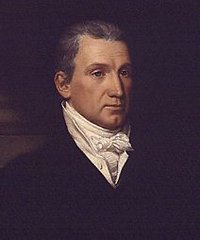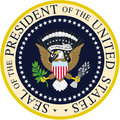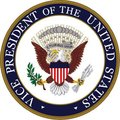James Monroe
|
|
| ||
| Order: | 5th President | |
| Vice President: | Daniel D. Tompkins | |
| Term of office: | March 4, 1817 – March 4, 1825 | |
| Preceded by: | James Madison | |
| Succeeded by: | John Quincy Adams | |
| Date of birth: | April 28, 1758 | |
| Place of birth: | Westmoreland County, Virginia | |
| Date of death: | July 4, 1831 | |
| Place of death: | New York City | |
| First Lady: | Elizabeth Kortright Monroe | |
| Political party: | Democratic-Republican | |
James Monroe (April 28, 1758 – July 4, 1831) was the fifth (1817–1825) President of the United States. He is the namesake of the Monroe Doctrine, although it was his Secretary of State, John Quincy Adams, who actually devised it.
| Contents |
Early years
Born in Westmoreland County, Virginia, as an only child to a prosperous family, Monroe attended the school of Campelltown Academy in Viginia and then attended the College of William and Mary, fought with distinction in the Continental Army, and practiced law in Fredericksburg, Virginia. His parents Spence Monroe (ca. 1727-1774) and Elizabeth Jones (born ca. 1729) were well-to-do farmers.
As a youthful politician, he joined the anti-Federalists in the Virginia Convention which ratified the Constitution, and in 1790, an advocate of Jeffersonian policies, was elected United States Senator. As Minister to France in 1794-1796, he displayed strong sympathies for the French cause; later, with Robert R. Livingston and under the direction of President Thomas Jefferson, he helped negotiate the Louisiana Purchase.
Presidency
Following the War of 1812, Monroe was elected president in the election of 1816, and re-elected in 1820. Monroe, the last American Revolutionary War veteran to serve as president, was almost uncontested in his two elections.
Monroe made strong Cabinet choices, naming a Southerner, John C. Calhoun, as Secretary of War, and a Northerner, John Quincy Adams, as Secretary of State. Only Henry Clay's refusal kept Monroe from adding an outstanding Westerner. Both of these individuals are considered outstanding leaders of their time.
Monroe's presidency was later labeled "The Era of Good Feelings", in part because partisan politics were almost nonexistent. The Federalist Party had died out, and the rift between the Democratic Party and the Whig Party had not yet happened. Practically every politician belonged to the Democratic-Republican Party.
Unfortunately these "good feelings" did not endure, although Monroe, his popularity undiminished, followed nationalist policies. Across the facade of nationalism, ugly sectional cracks appeared. A painful economic depression undoubtedly increased the dismay of the people of the Missouri Territory in 1819 when their application for admission to the Union as a slave state failed. An amended bill for gradually eliminating slavery in Missouri precipitated two years of bitter debate in Congress. The Missouri Compromise bill resolved the struggle, pairing Missouri as a slave state with Maine, a free state, and barring slavery north and west of Missouri forever.
Monroe is probably best known for the Monroe Doctrine, which he delivered in his message to Congress on December 2, 1823. In it, he proclaimed the Americas should be free from future European colonization and free from European interference in sovereign countries' affairs. It further stated the United States's intention to stay neutral in European wars and wars between European powers and their colonies but to consider any new colonies or interference with independent countries in the Americas as hostile acts toward the United States. Monroe did not begin formally to recognize the young sister republics until 1822, after ascertaining that Congress would vote appropriations for diplomatic missions. He and Secretary of State John Quincy Adams wished to avoid trouble with Spain until it had ceded the Floridas, as was done in 1821.
The United Kingdom, with its powerful navy, also opposed reconquest of Latin America and suggested that the United States join in proclaiming "hands off." Ex-Presidents Jefferson and Madison counseled Monroe to accept the offer, but Secretary Adams advised, "It would be more candid ... to avow our principles explicitly to Russia and France, than to come in as a cock-boat in the wake of the British man-of-war." Monroe accepted Adams's advice. Not only must Latin America be left alone, he warned, but also Russia must not encroach southward on the Pacific coast. "... the American continents," he stated, "by the free and independent condition which they have assumed and maintain, are henceforth not to be considered as subjects for future colonization by any European Power." Some 20 years after Monroe died in 1831, this became known as the Monroe Doctrine.
Post-Presidency
Upon leaving the White House after Monroe's presidency expired on March 4, 1825, James Monroe had racked up debts over the years of public life. As a result, he was forced to sell off his Ash Lawn plantation to pay off the debts, since then he never financially recovered. As a result, he and his wife Elizabeth lived in Oak Hill until Elizabeth's death on September 23, 1830. Upon Elizabeth's death, Monroe sold Oak Hill to live with his daughter Maria Hester Monroe Gouverneur in New York City and died there peacefully from heart failure and tuberculosis on July 4, 1831; 55 years after the Declaration of Independence was proclaimed and 5 years after the death of Presidents John Adams and Thomas Jefferson.
Cabinet
| OFFICE | NAME | TERM |
| President | James Monroe | 1817–1825 |
| Vice President | Daniel Tompkins | 1817–1825 |
| Secretary of State | John Quincy Adams | 1817–1825 |
| Secretary of the Treasury | William H. Crawford | 1817–1825 |
| Secretary of War | George Graham (ad interim) | 1817 |
| John C. Calhoun | 1817–1825 | |
| Attorney General | Richard Rush | 1817 |
| William Wirt | 1817–1825 | |
| Postmaster General | Return Meigs | 1817–1823 |
| John McLean | 1823–1825 | |
| Secretary of the Navy | Benjamin Crowninshield | 1817–1818 |
| John C. Calhoun | 1818–1819 | |
| Smith Thompson | 1819–1823 | |
| Samuel L. Southard | 1823–1825 | |
Supreme Court appointments
Monroe appointed the following Justices to the Supreme Court of the United States:
States Admitted to the Union
- Mississippi – December 10, 1817
- Illinois – December 3, 1818
- Alabama – December 14, 1819
- Maine – March 15, 1820
- Missouri – August 10, 1821
See also
- U.S. presidential election, 1816
- U.S. presidential election, 1820
- List of places named for James Monroe
- Oak Hill Plantation
- American Colonization Society
History Clipart and Pictures
- Pictures of the US Presidents (http://classroomclipart.com/cgi-bin/kids/imageFolio.cgi?direct=History/United_States/Presidents)
- Clipart of American Presidents (http://classroomclipart.com/cgi-bin/kids/imageFolio.cgi?direct=Clipart/American_Presidents)
- Historical Pictures of the United States (http://classroomclipart.com/cgi-bin/kids/imageFolio.cgi?direct=History/United_States)
- Pictures of the American Revolution (http://classroomclipart.com/cgi-bin/kids/imageFolio.cgi?direct=History/United_States/American_Revolution)
- Civil Rights Pictures (http://classroomclipart.com/cgi-bin/kids/imageFolio.cgi?direct=History/United_States/Civil_Rights)
- Civil War Images (http://classroomclipart.com/cgi-bin/kids/imageFolio.cgi?direct=History/United_States/Civil_War)
- Pictures of Colonial America (http://classroomclipart.com/cgi-bin/kids/imageFolio.cgi?direct=History/United_States/Colonial_America)
- Historical US Illustrations (http://classroomclipart.com/cgi-bin/kids/imageFolio.cgi?direct=History/United_States/Illustrations)
- World War II Pictures (http://classroomclipart.com/cgi-bin/kids/imageFolio.cgi?direct=History/United_States/World_War_II)
- Pictures of Historical People (http://classroomclipart.com/cgi-bin/kids/imageFolio.cgi?direct=History/United_States/People)
External links
- The Papers of James Monroe (http://www.yale.edu/lawweb/avalon/presiden/monroepa.htm) at the Avalon Project (includes Inaugural Addresses and other materials)
- A genealogical profile of the President (http://www.algerclan.org/cgi-bin/igmget.cgi/n=Alger?I8949)



